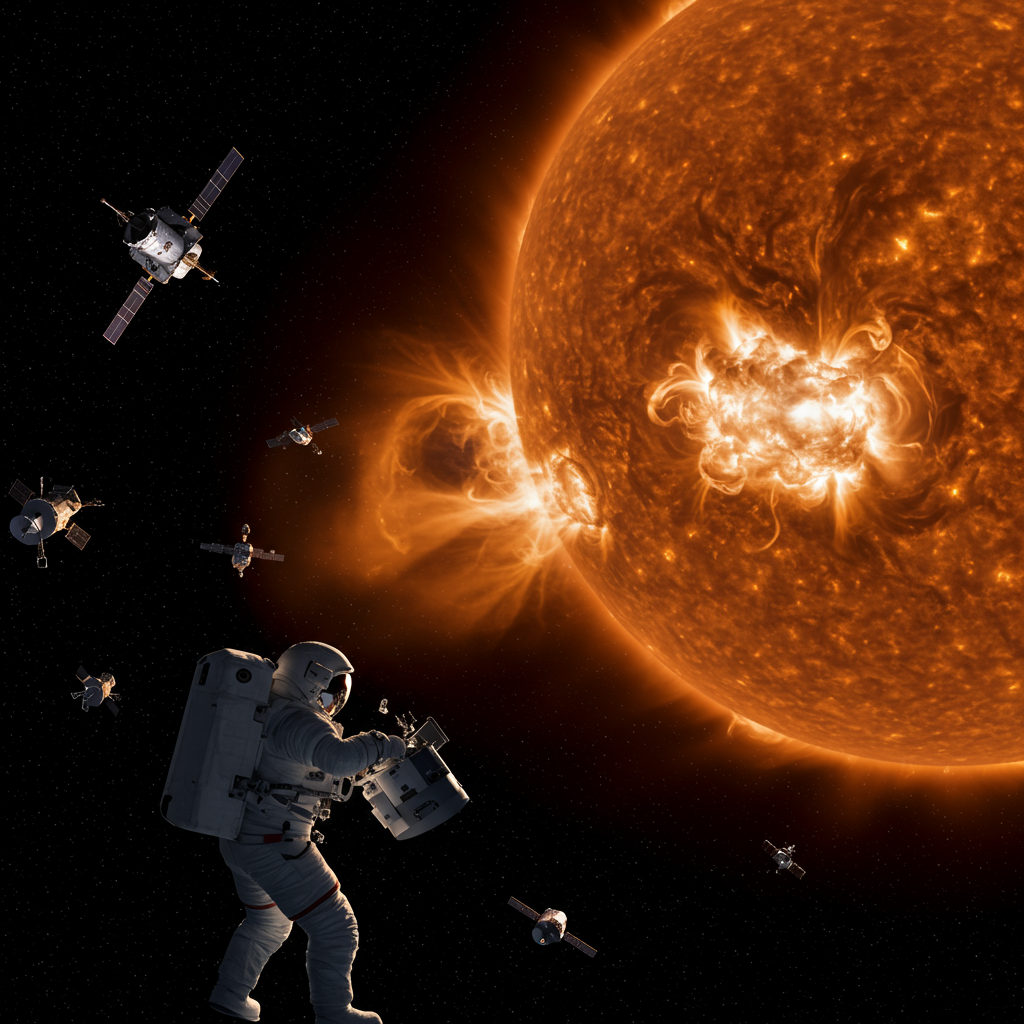The sun, our life-giving star, constantly surprises us. New groundbreaking research reveals that the most violent eruptions on its surface, known as solar flares, reach astonishing temperatures far exceeding previous estimates. Scientists now understand these powerful phenomena can blaze at a scorching 180 million degrees Fahrenheit—over six times hotter than once believed. This redefines our understanding of space weather and carries profound implications for safeguarding our technology and astronauts in orbit.
Redefining Solar Heat: A Shocking Discovery
For decades, solar physicists meticulously studied solar flares, powerful bursts of radiation and energy from the sun. These beautiful yet dangerous events occur when magnetic energy, stored in the sun’s atmosphere, is suddenly released. The conventional wisdom for measuring their extreme heat focused primarily on the temperature of electrons within the flare. Researchers observed these electrons and, critically, assumed that the heavier ions—the other charged particles present—would achieve similar temperatures. This long-held assumption underpinned most of our understanding of solar flare mechanics.
However, a recent study published in Astrophysical Journal Letters completely reshapes this view. Alexander Russell, a physicist from the University of St. Andrews in Scotland, described the newly calculated temperatures as “a crazy number” that he and his colleagues initially found “incredible.” Their findings indicate that solar flares aren’t just hot; they are a superheated inferno, far more extreme than any prior measurement suggested. This dramatic upward revision to 180 million degrees Fahrenheit forces a comprehensive re-evaluation of how these solar behemoths truly operate.
The Unseen Inferno: Why Ions Heat Differently
The core of this scientific re-evaluation lies in a fundamental distinction: ions and electrons do not heat up equally during a solar flare. When magnetic energy erupts, it “dumps” into these particles, accelerating and heating them to immense levels. While electrons are indeed propelled at incredible speeds and reach high temperatures, recent computer simulations and direct measurements from near-Earth space have unveiled a critical fact: ions experience a significantly more intense heating process.
This disparity was largely overlooked in previous research. As James Drake, a physicist at the University of Maryland who has extensively studied magnetic processes, explains, solar physicists had been “missing something big” by concentrating solely on electron measurements. The new calculations by Russell and his team, informed by these advanced simulations and measurements, demonstrate that when the more substantial heating of ions is factored in, the overall temperature of solar flares skyrockets. Understanding this differential heating mechanism is paramount to accurately modeling the physics of these solar events.
Far-Reaching Implications of Extreme Heat
The revelation that solar flares burn at such extraordinary temperatures isn’t merely an academic curiosity; it has tangible, critical implications for our spacefaring civilization and our planet. Space weather, driven by solar phenomena like flares and coronal mass ejections (CMEs), can profoundly impact Earth.
Satellite Protection: Our modern world relies heavily on satellites for communication, navigation (GPS), weather forecasting, and defense. Extreme solar flares can generate intense radiation and geomagnetic storms that damage satellite electronics, disrupt signals, and even lead to complete satellite failure. A more accurate understanding of their heat and energy output allows engineers to design more resilient spacecraft and implement better protective measures during active solar periods.
Astronaut Safety: For astronauts aboard the International Space Station or those embarking on future deep-space missions to the Moon or Mars, solar flares pose a direct radiation hazard. High-energy particles released during flares can penetrate spacecraft shielding, increasing astronauts’ risk of radiation sickness and long-term health issues. Knowing the true intensity of these flares enables better risk assessment, improved shielding designs, and more effective warning systems for human spaceflight.
Power Grid Stability: While less direct, powerful solar storms associated with flares can induce currents in Earth’s power grids, potentially leading to widespread blackouts. The infamous Carrington Event of 1859, a massive solar storm, crippled telegraph systems globally. Today, our interconnected grids are even more vulnerable. This new understanding helps refine predictions of space weather severity, allowing grid operators to take proactive measures.
This enhanced knowledge is a crucial step towards mitigating the risks posed by these dangerous yet awe-inspiring eruptions. It empowers us to develop more sophisticated predictive models and implement better safeguards.
Pioneering Future Research and Preparedness
The scientific community is not resting on this groundbreaking discovery. Alexander Russell confirms that his team is “already busy on the next steps,” actively developing more advanced models. These future models will specifically account for how flares evolve when ions are heated much more strongly than electrons. This critical research aims to move beyond simple temperature measurements and delve into the dynamic processes of energy transfer within flares.
Improved models will lead to:
More Accurate Predictions: Better forecasts of when and where solar flares will occur, and crucially, their potential impact.
Enhanced Space Weather Warnings: Timelier and more precise alerts for satellite operators and mission control centers.
Deeper Understanding of Plasma Physics: Illuminating fundamental processes of magnetic reconnection and particle acceleration that have applications beyond just solar physics.
This ongoing quest for knowledge underscores the importance of continuous observation, cutting-edge simulations, and collaborative scientific efforts. As we venture further into space, a comprehensive understanding of our star’s volatile nature becomes ever more vital for our safety and technological advancements.
Frequently Asked Questions
Why were previous solar flare temperature estimates inaccurate?
Previous estimates primarily measured the temperature of electrons within solar flares, assuming that ions, the other charged particles, would heat up to a similar degree. However, recent computer simulations and direct measurements from near-Earth space have revealed this assumption was incorrect. Ions actually experience a significantly more intense heating process during a flare than electrons. Once this differential heating was factored into new calculations, it showed that the overall temperature of solar flares is far higher, reaching up to 180 million degrees Fahrenheit, rather than the previously believed 30 million degrees Fahrenheit.
How does this new understanding of solar flare temperatures protect space missions?
A more accurate understanding of the extreme temperatures and energy dynamics of solar flares is crucial for improving safety and protection strategies. Knowing that flares are significantly hotter means they release more intense radiation and energy. This data allows engineers to design more robust and radiation-hardened components for satellites, improving their resilience against solar storm damage. For astronauts, it leads to better risk assessments, the development of enhanced shielding for spacecraft, and more effective early warning systems to mitigate exposure to hazardous radiation during human space missions.
Who are the key researchers behind this groundbreaking solar flare discovery?
The groundbreaking research that re-evaluated solar flare temperatures was led by Alexander Russell, a physicist from the University of St. Andrews in Scotland. His team conducted the new calculations and analysis, which were published in Astrophysical Journal Letters. The findings are supported by other experts in the field, including James Drake, a physicist at the University of Maryland, who has extensively studied how magnetic processes accelerate and heat particles like electrons and ions, and has consistently highlighted the importance of understanding their differing heating mechanisms.
Conclusion
The sun continues to be a source of scientific wonder and formidable power. The discovery that solar flares burn at an astonishing 180 million degrees Fahrenheit marks a pivotal moment in solar physics. This re-evaluation, driven by new insights into how ions and electrons heat differently, fundamentally alters our understanding of these solar eruptions. Beyond the scientific thrill, this knowledge is a critical tool for predicting space weather more accurately and enhancing our ability to protect the vital satellites that power our modern lives, as well as the brave astronauts who venture beyond Earth’s protective embrace. As research continues, we move closer to mastering the challenges posed by our dynamic star.




